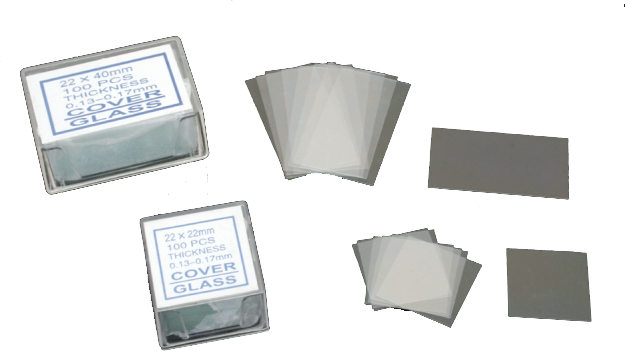
Covers Glass
Fluorescence microscopy is a technique used to identify cells, tissues and molecules that have been tagged with a fluorescent dye. Cover glasses are specially designed to fit over the microscope's objective lens to protect it from dust and other particles. We offer a range of cover glasses for fluorescence microscopy, including glass, plastic (PMMA) and polycarbonate.
Item No.: GCE1272
Thickness: 0.13 - 0.17mm
Size: 10 x10mm, 12 x12mm, 14 x14mm, 16 x16mm,
18 x 18mm, 20 x 20mm, 22 x 22mm, 24 x 24mm, 24 x 32mm, 24 x 40mm, 24 x 50mm, 24 x 60mm etc.
Cover glasses are microscope slides that are used to protect the sample being examined. They are usually made of a transparent material such as glass or plastic. Cover glasses can be either flat or curved, and they come in a variety of sizes and thicknesses. Cover glasses are an important part of fluorescence microscopy because they help to reduce background noise and improve contrast. Fluorescence microscopy is a type of microscopy that uses light to excite a fluorescent dye, which then emits light at a different wavelength. This allows for the identification of specific structures or molecules within a sample. Curved cover glasses are often used in fluorescence microscopy because they help to focus the light onto the sample and minimize reflections. Flat cover glasses can also be used, but they may cause some distortion of the image. The size and thickness of the cover glass will depend on the type of microscope being used and the desired level of magnification. Cover glasses are an essential part of any fluorescence microscopy setup, and choosing the right cover glass can make a big difference in the quality of your images.
Cover glasses are an important part of fluorescence microscopy, as they protect the sample from damage and allow for even illumination. There are a variety of cover glass sizes available, each with its own advantages and disadvantages. The most common cover glass size is 18 x 18mm, which offers a good balance between coverage and cost. However, larger sizes such as 24 x 24mm or 26 x 34mm may be necessary for certain applications. These larger sizes can be more expensive and may require a custom microscope stage. The thickness of the cover glass also needs to be considered. Thicker glasses (up to 1mm) can offer better protection for delicate samples, but they can also scatter light and reduce contrast. For most applications, a standard 0.17-0.5mm thick glass is sufficient. Finally, the type of cover glass also needs to be considered. The two most common types are borosilicate and quartz, both of which have their own advantages and disadvantages. Quartz is more resistant to heat and chemicals, but it is also more expensive. Borosilicate is less expensive but can break more easily if mishandled.
High quality cover glass for microscopy is an essential component for many applications in the life sciences. There are many different types of cover glasses available, each with their own advantages and disadvantages. The most important factor to consider when choosing a cover glass is the optical quality. Cover glasses with poor optical quality will result in blurry or distorted images. There are two main types of cover glasses: soda lime glass and borosilicate glass. Soda lime glass is the most common type of cover glass and is typically used for routine microscopy. Borosilicate glass is more expensive but has superior optical quality. It is often used for high-resolution microscopy or when extreme precision is required. When selecting a cover glass, it is also important to consider the thickness and size. Thickness can range from 0.13 mm to 1 mm, with 0.17 mm being the most common thickness used in microscopy. Cover glasses are typically available in sizes ranging from 22 mm x 22 mm to 50 mm x 50 mm. The size you choose will depend on the application you are using it for as well as the microscope you are using it with. Cover glasses can be purchased from scientific supply companies or online retailers. Be sure to select a reputable supplier who offers high-quality products and good customer service.
There are several special features to consider when selecting cover glasses for fluorescence microscopy. First, the glass must be of a high enough quality to allow for the passage of light at the desired wavelength. Additionally, the glass must be free of any blemishes or imperfections that could distort the image. Finally, the glass must be thick enough to protect the specimen from damage during the imaging process.